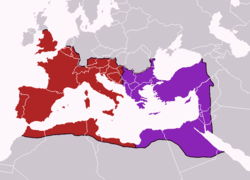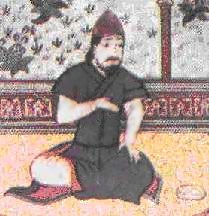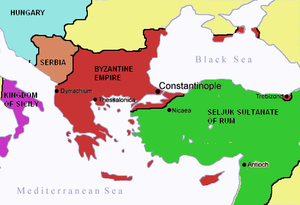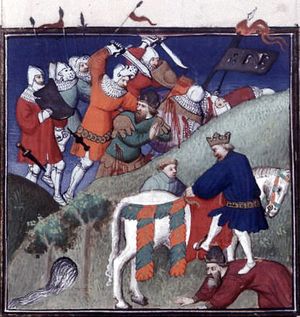الحروب البيزنطية السلجوقية
| Byzantine–Seljuq wars | |||||||
|---|---|---|---|---|---|---|---|
| |||||||
| المتحاربون | |||||||
|
Byzantine Empire Empire of Trebizond the Crusader States | |||||||
| القوى | |||||||
|
c. 1071 : Could raise up to 100,000 troops 1140 : 25,000 to 50,000 field troops | unknown | ||||||
The Byzantine–Seljuq Wars (تركية: Bizans-Selçuklu Savaşları) were a series of decisive battles that shifted the balance of power in Asia Minor and Syria from the European Byzantine Empire to the Central Asian Seljuq. Riding from the steppes of Central Asia, the Seljuq replicated tactics practiced by the Huns hundreds of years earlier against a similar Roman opponent but now combining it with new-found Islamic zeal; in many ways, the Seljuq resumed the conquests of the Muslims in the Byzantine–Arab Wars initiated by the Rashidun, Umayyad and Abassid Caliphate in the Levant, North Africa and Asia Minor.
Today, the Battle of Manzikert is widely seen as the moment when the Byzantines lost the war against the Turks; however the Byzantine military was of questionable quality before 1071 with regular Turkish incursions overrunning the failing theme system. Even after Manzikert, Byzantine rule over Asia Minor did not end immediately, nor were any heavy concessions levied by the Turks on their opponents – it took another 20 years before the Turks were in control of the entire Anatolian peninsula and not for long either.
During the course of the war, the Seljuq Turks and their allies attacked the Fatimid Caliphate of Egypt, capturing Jerusalem and catalyzing the call for the First Crusade. Crusader assistance to the Byzantine Empire was mixed with treachery and looting, although substantial gains were made in the First Crusade. Within a hundred years of Manzikert, the Byzantines had (with Crusader assistance) successfully driven back the Turks from the coasts of Asia Minor and extended their influence right down to Palestine and even Egypt. Later, the Byzantines were unable to extract any more assistance, and the Fourth Crusade even led to the sack of Constantinople. Before the conflict petered out, the Seljuqs managed to take more territory from the weakened Empire of Nicaea until the Sultanate itself was taken over by the Mongols, leading to the rise of the ghazis and the conclusive Byzantine–Ottoman wars.
Origins
Initial Conflicts: 1064–1071
Turkic Conquests: 1071–1096
Byzantium Survives: 1096–1118
Byzantine counter-attack: 1118–1176

John II Comnenus
Manuel Comnenus
Byzantine Collapse 1180–1308
Analysis
Byzantine army
| Year | Population | Soldiers | Area |
|---|---|---|---|
| 1025 | 12,000,000 | 110,000 | Byzantine Empire |
| 1143 | 10,000,000 | 50,000 | Byzantine Empire |
| 1204 | 9,000,000 | 30,000+ | Byzantine Empire |
| 1281 | 5,000,000 | 20,000 | Byzantine Empire[1] |
Crusades
Seljuq Turks
Conclusion
Consequences
انظر أيضاً
- Seljuq Turks
- Komnenian army
- Byzantine military
- Decline of the Byzantine Empire
- Rise of the Ottoman Empire
- Second Crusade
- Third Crusade
References
- ^ "World Gazetteer, Greece". Archived from the original on 1 أكتوبر 2007. Retrieved 30 يناير 2007.
{{cite web}}: Unknown parameter|dead-url=ignored (|url-status=suggested) (help) - ^ "" Des Cas des nobles hommes et femmes ", de " JEHAN BOCCACE ", traduction de " LAURENT DE PREMIERFAIT "". Gallica.
- ^ http://www.allempires.com/empires/seljuk/seljuk_warriors_enh.jpg
Further reading
- Bentley, Jerry H.; Ziegler, Herbert (2006). Traditions & Encounters a Global Perspective on the Past (3rd ed.). Boston: McGraw–Hill. ISBN 0-07-295754-9.
{{cite book}}: Invalid|ref=harv(help) - Cahen, Claude (1968). Pre-Ottoman Turkey: A General Survey of the Material and Spiritual Culture and History c.1071-1330. New York: Taplinger.
{{cite book}}: Invalid|ref=harv(help) - Chahin, Mark (2001). The Kingdom of Armenia. London: Routledge. ISBN 0-7007-1452-9.
{{cite book}}: Invalid|ref=harv(help) - Grant, R. G. (2005). Battle a Visual Journey Through 5000 Years of Combat. London: Dorling Kindersley. ISBN 1-4053-1100-2.
{{cite book}}: Invalid|ref=harv(help) - Haldon, John (2002). Byzantium at War: AD 600–1453. Oxford: Osprey. ISBN 1-84176-360-8.
{{cite book}}: Invalid|ref=harv(help) - Madden, Thomas F. (2005). Crusades the Illustrated History (1st ed.). Ann Arbor: University of Michigan Press. ISBN 0-472-03127-9.
{{cite book}}: Invalid|ref=harv(help) - Mango, Cyril (2002). The Oxford History of Byzantium (1st ed.). New York: Oxford University Press. ISBN 0-19-814098-3.
{{cite book}}: Invalid|ref=harv(help) - Parker, Geoffrey (2005). Compact History of the World (4th ed.). London: Collins. ISBN 0-00-721411-1.
{{cite book}}: Invalid|ref=harv(help) - Phillips, Jonathan (2014). The Crusades, 1095-1204. New York: Routledge. ISBN 978-0-415-73636-7.
{{cite book}}: Invalid|ref=harv(help) - Sherrard, Philip (1966). "Great Ages of Man Byzantium". New York: Time-Life Books.
{{cite journal}}: Cite journal requires|journal=(help); Invalid|ref=harv(help) - Vryonis, Speros (1971). The Decline of Medieval Hellenism in Asia Minor and the Process of Islamization from the Eleventh through the Fifteenth Century. Berkeley: University of California.
- CS1 errors: unsupported parameter
- Pages using Lang-xx templates
- Articles with hatnote templates targeting a nonexistent page
- مقالات ينقصها مصادر موثوقة
- مقالات ينقصها مصادر موثوقة from July 2009
- 11th-century conflicts
- 12th-century conflicts
- 13th-century conflicts
- Byzantine–Seljuq Wars
- 11th century in the Byzantine Empire
- 12th century in the Byzantine Empire
- 13th century in the Byzantine Empire
- Sultanate of Rum









